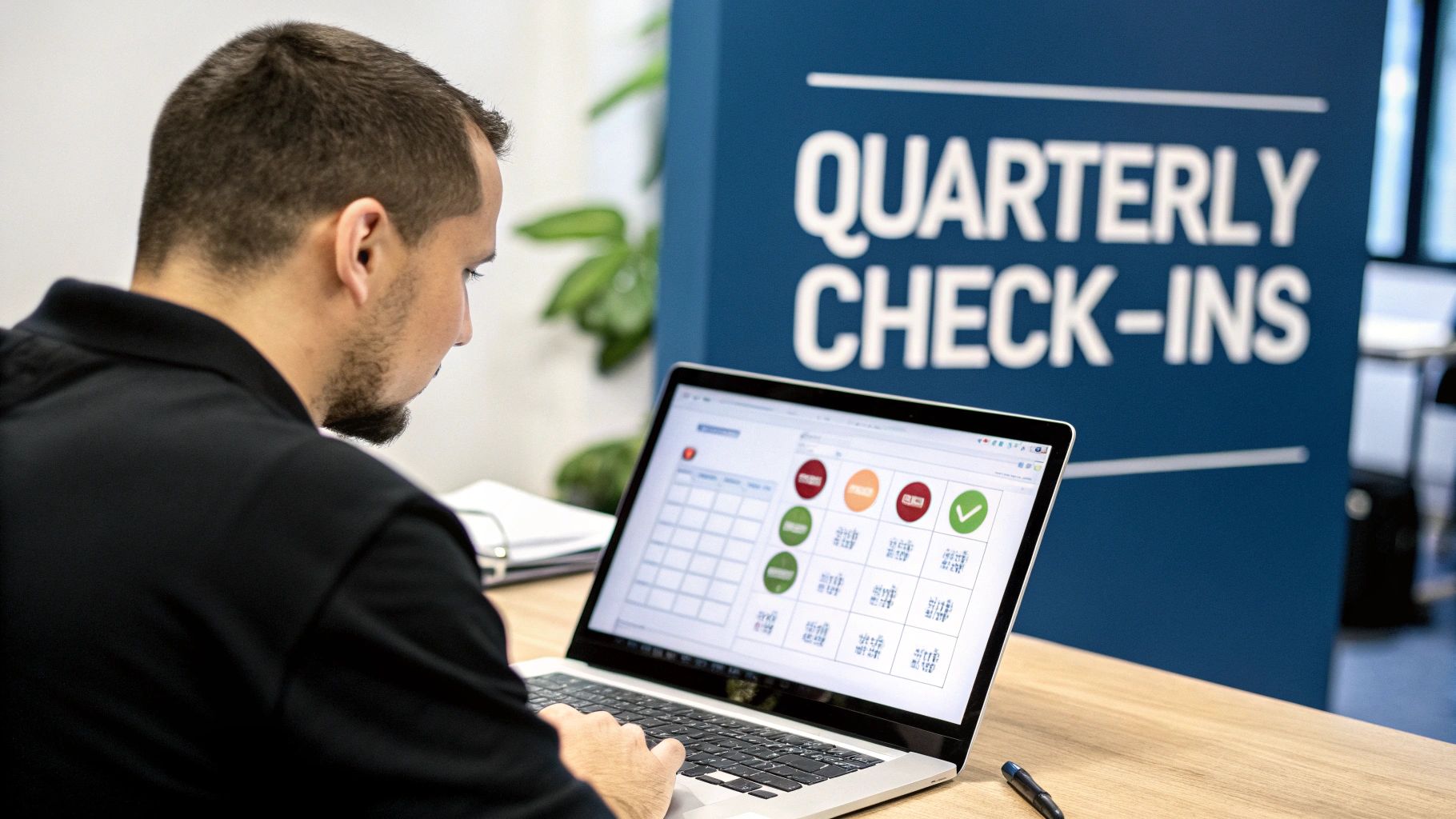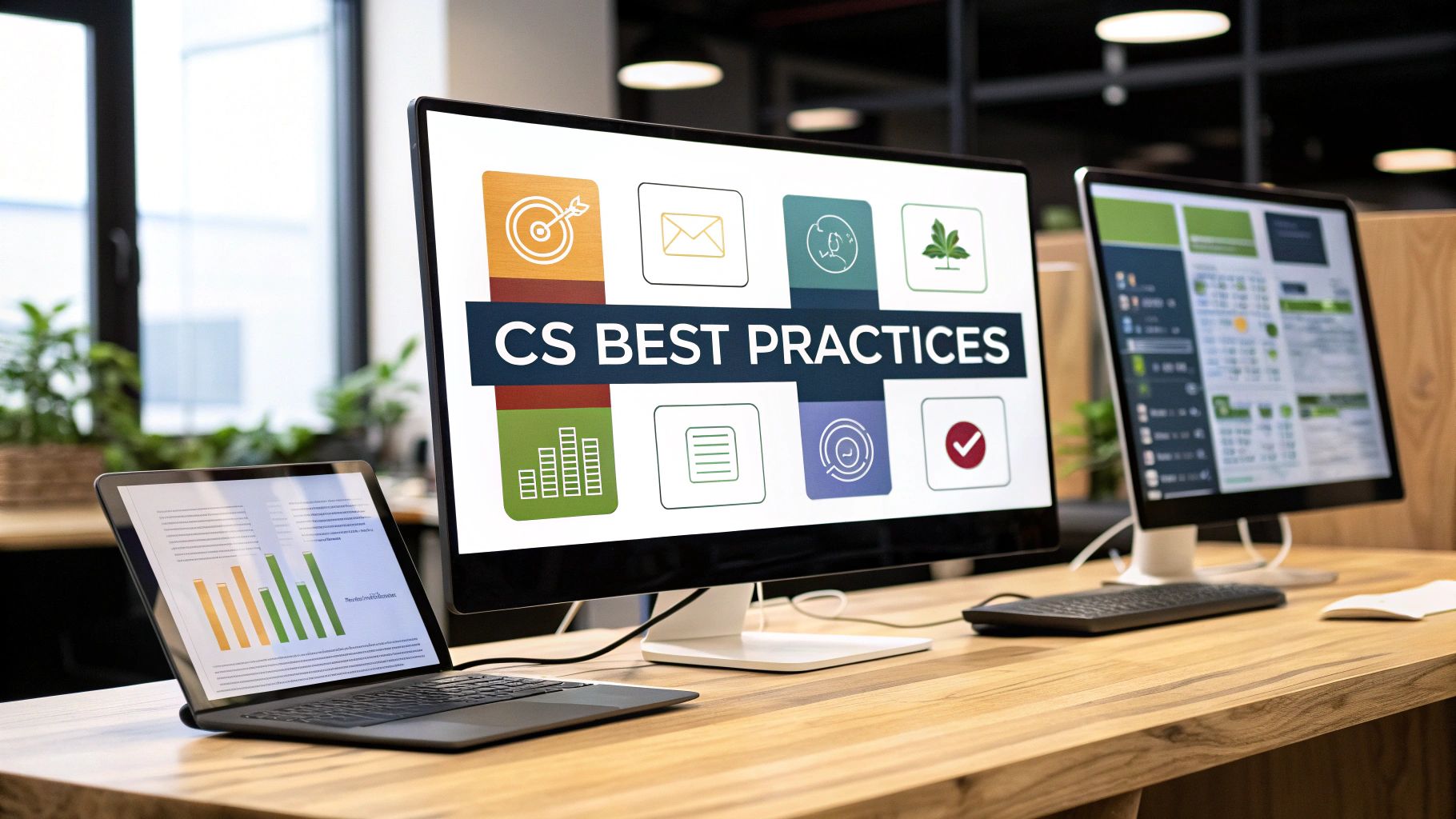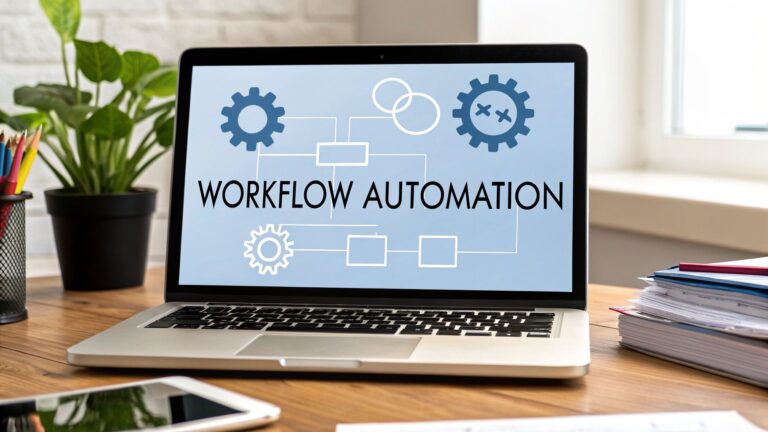10 Customer Success Best Practices for B2B Growth in 2025
In today's competitive B2B and SaaS landscape, customer acquisition is only half the battle. True, sustainable growth is built on retaining and expanding your existing customer base. This requires a strategic shift from reactive support to proactive partnership, a discipline known as customer success. But what does world-class customer success look like in practice? It's more than just answering support tickets; it's about systematically ensuring your customers achieve their desired outcomes while using your product or service.
Moving beyond generic advice, this guide provides a comprehensive list of 10 essential customer success best practices, complete with actionable frameworks, real-world examples, and specific implementation details. We've curated these insights to help you build and scale a CS function that directly impacts your bottom line. To effectively transition to a proactive growth model and redefine customer interactions, consider effective strategies to improve customer experience as a foundational element of your approach.
This article is your blueprint for reducing churn, boosting net revenue retention (NRR), and transforming customers into lifelong advocates. You will learn how to implement data-driven health scoring, optimize onboarding for faster time-to-value, and build scalable processes through automation. Whether you are establishing your first customer success team or refining an established one, these proven strategies will help you move from simply fixing problems to actively driving growth and demonstrating undeniable ROI. Let's explore the specific tactics that separate high-performing CS teams from the rest.
1. Proactive Customer Engagement and Regular Check-ins
Moving from a reactive support model to a proactive engagement strategy is a cornerstone of modern customer success best practices. Instead of waiting for customers to report problems, this approach involves establishing a systematic cadence of communication to ensure they are achieving their desired outcomes, which directly prevents churn and uncovers opportunities for growth. This means scheduling regular check-ins, strategic business reviews, and valuable relationship touchpoints that add value beyond basic support.

This proactive stance transforms the customer relationship from transactional to strategic. For example, Salesforce’s customer success managers (CSMs) conduct Quarterly Business Reviews (QBRs) to align with clients on long-term goals and demonstrate ROI. Similarly, HubSpot's structured and proactive onboarding process is designed to accelerate the customer's time-to-value, ensuring they experience the platform's benefits quickly and effectively.
How to Implement Proactive Engagement
To build a successful proactive engagement model, start by segmenting your customer base to determine the appropriate level of touch for each tier. High-value enterprise accounts may require monthly calls and quarterly in-person reviews, while smaller accounts might benefit from automated, yet personalized, email check-ins triggered by usage data.
- Establish a Cadence: Clearly define and communicate the frequency of check-ins with your customers from the beginning. This sets expectations and demonstrates your commitment to their success.
- Leverage Data for Insights: Before any interaction, your CSM should be armed with data. Analyze product usage, support ticket history, and health scores to personalize the conversation and offer relevant advice.
- Standardize with Playbooks: Create structured playbooks for different types of check-ins, such as 30-day onboarding reviews, QBRs, or renewal conversations. This ensures consistency and scalability across your customer success team.
- Track Outcomes: Every interaction should have a purpose and a measurable outcome. Track whether the check-in resulted in increased feature adoption, an expansion opportunity, or an improved health score. This data proves the ROI of your proactive efforts.
2. Onboarding and Time-to-Value Optimization
The initial onboarding experience is arguably the most critical phase in the customer lifecycle. Effective onboarding is not just about product training; it's a strategic process designed to guide new customers to their first moment of value as quickly as possible. This focus on accelerating "Time-to-Value" (TTV) is a fundamental customer success best practice because it validates the customer's purchase decision, builds early momentum, and drastically reduces the likelihood of early-stage churn. A seamless onboarding process sets the foundation for long-term loyalty and expansion.

This principle is about creating a structured, efficient, and often personalized journey that minimizes friction. For instance, Slack’s intuitive onboarding sequence encourages immediate user engagement by guiding new users to join channels and send their first message within minutes. Similarly, Asana utilizes template-based project setups during onboarding, allowing teams to organize complex workflows and see tangible progress almost instantly, accelerating their path to achieving desired outcomes.
How to Optimize Onboarding for Faster TTV
To engineer an effective onboarding experience, you must first deeply understand the key "aha!" moments that make your product indispensable to users. The goal is to create a guided path directly to these value points. For a deeper dive into structuring this process, you can explore these client onboarding best practices.
- Map Key Activation Milestones: Identify the 3-5 critical actions a new user must take to experience the core value of your product. Build your onboarding flow to guide them through these specific steps.
- Segment Onboarding Paths: Not all users are the same. Create tailored onboarding tracks based on user role, company size, or specific use cases to make the experience more relevant and efficient.
- Celebrate Early Wins: Use in-app messages, emails, or even CSM outreach to acknowledge when a customer completes a key milestone. This positive reinforcement builds confidence and encourages deeper engagement.
- Use Data to Identify Friction: Analyze user behavior during onboarding to pinpoint where they drop off or get stuck. Use this data to continuously iterate and remove roadblocks from the process.
3. Data-Driven Health Scoring and Risk Assessment
One of the most powerful customer success best practices is moving beyond subjective feelings and implementing a quantitative, data-driven approach to understand customer well-being. This involves creating a customer health score, a predictive model that aggregates various signals like product usage, engagement levels, and support history into a single, actionable metric. This score enables your team to proactively identify at-risk accounts before they churn and pinpoint healthy customers ripe for expansion, allowing for strategic prioritization of effort.

This methodology transforms customer success from a reactive fire-fighting function into a predictive, strategic powerhouse. For instance, platforms like Gainsight and Totango pioneered automated health scoring by combining multiple data streams to give CSMs a clear, color-coded (red, yellow, green) indicator of account status. Similarly, analytics tools like Amplitude allow companies to define and track behavioral cohorts, identifying which in-app actions correlate directly with long-term retention and value, which can then be fed into a health score.
How to Implement Data-Driven Health Scoring
Developing an effective health score requires a deep understanding of what signals truly predict customer outcomes. Begin by identifying the key data points that correlate with both churn and renewal, and build a weighted model that reflects their relative importance. This commitment to a numbers-based strategy is central to effective customer management. For a deeper dive into this philosophy, you can explore the principles of data-driven decision-making on makeautomation.co.
- Identify Predictive Metrics: Start by selecting 5-7 key metrics. These could include login frequency, adoption of sticky features, number of support tickets, and NPS scores.
- Weight Metrics Appropriately: Not all metrics are created equal. Analyze historical data to determine which signals have the strongest correlation with churn or expansion and assign a higher weight to them.
- Combine Quantitative and Qualitative Data: Supplement hard data with qualitative insights from CSMs. A "CSM pulse" score can capture nuances that data alone might miss, such as a change in executive sponsorship.
- Validate and Iterate: A health score is not a one-time project. Regularly validate its accuracy by comparing scores to actual churn and renewal rates, and update the model's weights at least quarterly to ensure it remains predictive and relevant.
4. Customer Success Planning and Goal Alignment
Defining what "success" means from the very beginning is a critical customer success best practice that creates shared accountability and a clear roadmap. This involves collaborating directly with customers to establish mutually agreed-upon business objectives and key performance indicators (KPIs). Instead of assuming value, this practice ensures both you and your customer are working toward the same measurable outcomes, transforming the relationship from a simple vendor transaction into a strategic partnership.
This strategic alignment is the standard for enterprise SaaS leaders. For instance, companies like Workday and ServiceNow invest heavily in creating detailed success plans during the post-sale handoff. These plans don't just outline product implementation; they connect specific platform features to the customer's high-level business goals, such as increasing operational efficiency by 15% or reducing employee onboarding time by 40 hours. Zendesk also champions this with their outcome-based customer plans, which serve as a living document guiding the entire customer journey.
How to Implement Success Planning and Goal Alignment
To effectively implement success planning, integrate it into the early stages of the customer lifecycle, ideally during onboarding. This sets the foundation for every future interaction, from check-ins to business reviews.
- Schedule a Formal Planning Session: Host a dedicated kickoff or strategy session early in the relationship. Crucially, ensure both operational contacts and executive stakeholders from the customer's side are present to gain full buy-in.
- Define Primary Success Metrics: Collaboratively identify 3-5 core business metrics that your product will directly impact. These should be specific, measurable, achievable, relevant, and time-bound (SMART).
- Break Goals into Milestones: Deconstruct the overarching goals into smaller, quarterly milestones. This makes progress tangible and allows for regular course correction, preventing surprises at the end of the year.
- Document and Socialize the Plan: Create a formal success plan document and share it widely within the customer's organization and your own. This ensures everyone, from the CSM to the support agent, understands the customer's objectives.
- Establish a Review Cadence: Review progress against the plan consistently. This often means monthly check-ins with day-to-day contacts and more strategic quarterly reviews with executive leadership to demonstrate ROI.
5. Cross-Functional Alignment and Collaboration
A customer's experience is not limited to their interactions with the customer success team. True customer-centricity, a core tenet of customer success best practices, requires breaking down internal silos and fostering deep collaboration between sales, marketing, product, and support. This alignment ensures a seamless and consistent journey, where every departmental touchpoint reinforces value rather than creating friction. It formalizes communication channels, establishes shared objectives, and unites the entire organization around customer outcomes.
This unified approach prevents customers from feeling like they are dealing with separate companies. For instance, Stripe’s customer operations model integrates sales and success functions to create a fluid pre-to-post-sale experience. Similarly, Atlassian has built a powerful product feedback loop where insights from customer success are systematically channeled directly to engineering, ensuring the product roadmap reflects real user needs and pain points.
How to Implement Cross-Functional Alignment
Building a collaborative culture starts with establishing shared goals and formalizing processes for inter-departmental communication. The goal is to create a single, cohesive team dedicated to the customer's lifecycle, from initial acquisition to long-term advocacy.
- Establish Shared KPIs: Align teams around customer-centric metrics like Net Revenue Retention (NRR) or Customer Lifetime Value (CLV). When sales, marketing, and CS all share a goal, their strategies and actions naturally become more coordinated.
- Document Handoff Procedures: Create clear, documented playbooks for key customer transitions, especially the handoff from sales to customer success. Define what information must be shared, who is responsible, and what the customer should expect.
- Create Shared Visibility: Use a centralized CRM or customer success platform to create shared dashboards. When the product team can see common support tickets and the sales team can see product usage data, everyone gains a 360-degree view of the customer.
- Schedule Cross-Functional Meetings: Implement a regular cadence of meetings, such as monthly customer reviews, where representatives from each department can discuss at-risk accounts, identify expansion opportunities, and share critical feedback.
6. Scalable Customer Success Processes and Automation
As a company grows, delivering high-touch, personalized customer success to every single client becomes unsustainable. This is where scalable processes and automation become critical customer success best practices. The goal is to design repeatable, efficient workflows and leverage technology to manage a growing customer base without a proportional increase in headcount. This involves using automation for routine tasks, creating templates for common communications, and implementing a segmented service model.
This strategic approach allows CSMs to focus their high-value time on complex, strategic issues rather than repetitive tasks. For example, Gainsight uses its own platform to automate workflows, triggering tasks for CSMs when a customer's health score drops or sending automated onboarding emails. Similarly, Intercom excels at using automated, in-app messages and bots to guide users, answer common questions, and announce new features, delivering value at scale to thousands of users simultaneously.
How to Implement Scalable Processes and Automation
Building a scalable customer success engine requires a thoughtful blend of technology and strategy. Start by identifying the most time-consuming, repetitive tasks that your team performs and assess their potential for automation. This frees up your team for more strategic, high-impact activities.
- Segment for a "Right-Touch" Model: Not all customers require the same level of attention. Segment your customers into tiers (e.g., high-touch, low-touch, tech-touch) and apply different levels of automation and human interaction to each.
- Automate High-Volume Tasks: Implement automation for tasks like onboarding welcome sequences, usage-based feature recommendations, and renewal reminders for lower-tier accounts.
- Build in Human Escalation Paths: Automation should not be a dead end. Ensure that every automated workflow has a clear and easy path for a customer to connect with a human CSM when they need more complex support.
- Maintain Personalization: Use customer data to personalize automated communications. Addressing customers by name and referencing their specific product usage or company goals makes automated outreach feel more human and relevant.
7. Customer Training and Enablement Programs
Investing in comprehensive training and enablement programs is a powerful customer success best practice that empowers users to become product experts. Instead of relying solely on support teams for answers, this strategy equips customers with the knowledge and skills to maximize product value independently. This approach reduces support ticket volume, accelerates product adoption, and creates a more self-sufficient and satisfied user base.
This method turns education into a strategic advantage, fostering deep product proficiency and loyalty. For instance, Salesforce's Trailhead platform offers gamified learning paths and certifications that have become an industry standard, creating a community of certified professionals. Similarly, HubSpot Academy provides free courses and certifications that not only teach users how to use their software but also educate them on broader marketing and sales principles, positioning HubSpot as a thought leader.
How to Implement Training and Enablement Programs
To build an effective program, focus on creating accessible, role-specific content that addresses user needs at every stage of their journey. The goal is to make learning a continuous and engaging part of the customer experience, not a one-time onboarding event.
- Create Role-Specific Learning Paths: Develop distinct training tracks for different user personas, such as administrators, end-users, and executives. This ensures the content is relevant and immediately applicable to their specific responsibilities.
- Offer Diverse Content Formats: Cater to various learning styles by providing a mix of resources, including a searchable knowledge base, short video tutorials, in-depth webinars, and on-demand courses.
- Gamify the Learning Experience: Incorporate elements like points, badges, and certifications to motivate users and encourage course completion. This creates a sense of achievement and makes learning more enjoyable.
- Measure Engagement and Outcomes: Track key metrics such as course completion rates, certification numbers, and the impact on product adoption and support ticket volume. Use this data to prove the program's ROI and identify areas for improvement.
8. Voice of Customer and Feedback Collection
Systematically gathering, analyzing, and acting on customer feedback is a fundamental customer success best practice that bridges the gap between company assumptions and user reality. A robust Voice of the Customer (VoC) program ensures that product development, service improvements, and strategic decisions are directly informed by the needs and pain points of the people you serve. This moves beyond passive listening to an active, structured process of inquiry that uncovers deep insights and builds customer loyalty.
This customer-centric approach is a hallmark of product-led companies. For instance, Slack’s deep user research and continuous feedback loops directly inform feature development, ensuring new releases resonate with their user base. Similarly, Stripe’s product and engineering teams regularly conduct customer interviews to understand complex financial workflows, shaping a product that feels intuitive to developers and businesses. This direct line to the customer experience is what builds truly indispensable products.
How to Implement a VoC Program
An effective VoC program combines quantitative data with qualitative insights to create a holistic view of the customer experience. The goal is not just to collect feedback, but to operationalize it across the organization, ensuring insights lead to tangible improvements.
- Combine Quantitative and Qualitative Methods: Use surveys like Net Promoter Score (NPS) or Customer Satisfaction (CSAT) to track sentiment at scale. Complement this data with in-depth qualitative interviews, user research sessions, and focus groups to understand the "why" behind the numbers.
- Establish a Regular Cadence: Don't treat feedback collection as a one-time project. Implement regular surveys, such as quarterly NPS campaigns, to track trends over time. Schedule ongoing interviews with customers across different segments and health scores.
- Create Centralized Feedback Hubs: Funnel feedback from all sources (surveys, support tickets, CSM notes, social media) into a single, accessible location. This prevents valuable insights from getting lost in silos and allows for easier trend analysis.
- Close the Loop: The most critical step is demonstrating to customers that their feedback was heard and acted upon. When you release a feature or fix a bug based on their input, notify them directly. This simple act validates their effort and strengthens the partnership.
9. Churn Prediction and Retention Strategies
Anticipating customer churn before it happens is one of the most impactful customer success best practices, shifting teams from reactive damage control to proactive retention. This involves using historical data and predictive analytics to identify at-risk accounts, allowing you to deploy targeted intervention strategies that prevent revenue loss. By understanding the leading indicators of churn, you can engage customers with the right message at the right time, significantly extending their lifetime value.
This data-driven approach is fundamental to scalable retention. For instance, SaaS platforms like Gainsight and Totango build predictive models that analyze product usage, support ticket volume, and engagement levels to generate a churn risk score. Similarly, Netflix analyzes viewing habits to personalize content recommendations, a powerful retention tool that keeps users engaged. These companies don't wait for a cancellation email; they act on data signals to preserve the customer relationship proactively.
How to Implement Churn Prediction and Retention
Begin by identifying the key behaviors and metrics that correlate with both churn and long-term loyalty in your customer base. This requires a deep dive into historical data to build a reliable predictive model. You can learn more about how this works by exploring what predictive modeling is and its applications. Once you identify at-risk customers, you can deploy targeted playbooks to re-engage them.
- Identify Leading Indicators: Analyze your data to find early warning signs. Common indicators include a decline in product usage, a drop in key feature adoption, an increase in support tickets, or a key champion leaving the company.
- Build a Predictive Model: Use at least 12-18 months of historical customer data to create a statistical model. Incorporate a mix of behavioral, demographic, and firmographic data to improve its accuracy.
- Segment by Risk Level: Not all at-risk customers are the same. Segment them into high, medium, and low-risk categories to prioritize your team's outreach efforts and tailor the intervention strategy accordingly.
- Develop Retention Playbooks: Create specific, actionable plans for each risk segment. This could range from a high-touch call from a CSM for a high-risk account to an automated email campaign offering new training resources for a low-risk segment.
- Analyze and Iterate: Continuously monitor the effectiveness of your retention strategies. Conduct exit interviews with customers who do churn to understand the root causes and refine your predictive model and intervention playbooks.
10. Customer Success Team Structure and Segmentation Models
A one-size-fits-all approach to customer success is inefficient and unsustainable for scaling businesses. Implementing a strategic customer success team structure through segmentation is a fundamental best practice that ensures resources are allocated effectively. This model involves organizing your customer base into distinct tiers based on value, complexity, or growth potential, and then tailoring the level of engagement and service to match each segment's needs.
This segmented approach allows you to deliver high-touch, personalized service to your most valuable accounts while providing scalable, tech-touch support to your broader customer base. For instance, Salesforce famously tiers its customers into enterprise, mid-market, and SMB segments, each served by a dedicated team with specific playbooks and engagement cadences. Similarly, Zendesk organizes some of its success teams around industry verticals, recognizing that a financial services client has vastly different needs than a retail client.
How to Implement a Segmented Structure
Building an effective segmented model requires a data-driven approach to define tiers and align resources. The goal is to maximize impact where it matters most, preventing churn in high-value accounts and driving efficiency in lower-touch segments.
- Define Clear Segmentation Criteria: Base your tiers on concrete metrics like Annual Contract Value (ACV), growth potential, product complexity, or strategic importance. Avoid subjective assignments.
- Create Tier-Specific Playbooks: Develop distinct engagement strategies for each segment. A high-touch tier might receive quarterly business reviews and a dedicated CSM, while a low-touch tier is supported by automated email campaigns, webinars, and a rich knowledge base.
- Establish Escalation Paths: Create clear processes for customers to move between tiers or for issues to be escalated. A promising low-touch account showing high growth potential should have a clear path to receiving more dedicated attention.
- Monitor Segment-Specific Metrics: Track key performance indicators like Net Revenue Retention (NRR), churn rate, and health scores separately for each segment. This helps you validate the effectiveness of your model and identify where adjustments are needed.
Customer Success: 10 Best-Practices Comparison
| Practice / Program | Implementation complexity | Resource requirements | Expected outcomes | Ideal use cases | Key advantages |
|---|---|---|---|---|---|
| Proactive Customer Engagement and Regular Check-ins | Medium — scheduling, cadence design and coordination | CSM time, CRM workflows, multi-channel tools | Early risk detection, reduced churn, upsell opportunities | Mid-to-high-touch accounts, renewal management | Builds relationships, uncovers expansion |
| Onboarding and Time-to-Value Optimization | Medium–High — flows, content and role design | Onboarding specialists, product tours, analytics | Faster adoption, lower early churn, quicker ROI | New customers, complex products, PLG hybrid models | Shortens time-to-value, improves activation |
| Data-Driven Health Scoring and Risk Assessment | High — data pipelines, modeling and validation | Clean usage data, analytics tools, data science support | Prioritized accounts, early warning signals, efficient triage | Large customer bases, data-rich organizations | Objective prioritization, scalable risk detection |
| Customer Success Planning and Goal Alignment | Medium — workshops, KPI definitions and tracking | Executive time, planning templates, tracking tools | Shared expectations, measurable ROI, stronger exec relationships | Enterprise customers, strategic renewal/expansion | Aligns outcomes, enables executive buy-in |
| Cross-Functional Alignment and Collaboration | High — org change, governance and processes | Unified CRM, cross-team meetings, leadership sponsorship | Consistent customer experience, faster feedback loops | Complex products, scaling orgs, cross-functional initiatives | Reduces silos, improves product feedback speed |
| Scalable Customer Success Processes and Automation | Medium — automation design and maintenance | Automation platforms, playbooks, segmentation logic | Lower CS cost per customer, consistent delivery at scale | High-volume customers, rapid growth stages | Increases efficiency, frees capacity for high-touch work |
| Customer Training and Enablement Programs | Medium–High — curriculum, content production and delivery | Content creators, LMS/webinars, community managers | Higher product proficiency, fewer support tickets, advocates | Feature-rich products, enterprise deployments, partners | Builds capability, increases stickiness |
| Voice of Customer and Feedback Collection | Medium — survey design, research and analysis | Survey tools, UX/research resources, PM collaboration | Product improvements, validated roadmap, advocacy | Product roadmap decisions, feature prioritization | Customer-informed decisions, uncovers unmet needs |
| Churn Prediction and Retention Strategies | High — predictive models and targeted interventions | Historical data, data science, tailored retention campaigns | Reduced churn, extended LTV, targeted win-back efforts | Subscription models, high-churn segments | Efficient retention, cost-effective vs. new acquisition |
| Customer Success Team Structure and Segmentation Models | High — org design, tiering rules and handoffs | Staffing for tiers, playbooks, CRM segmentation | Optimized resource allocation, tailored service levels | Scaling companies with diverse customer profiles | Right-touch service, improved ROI and specialization |
Turn Best Practices into Business Impact with Automation
Throughout this guide, we've explored the essential pillars of a world-class customer success program. From engineering a frictionless onboarding experience to implementing data-driven health scoring and fostering cross-functional alignment, these ten customer success best practices represent the blueprint for sustainable growth. They are not isolated tactics but interconnected components of a single, powerful engine designed to maximize customer value and, in turn, your company's revenue.
The core takeaway is this: reactive, ad-hoc support is a relic of the past. Modern customer success is a proactive, strategic discipline. It's about anticipating needs before they become issues, aligning your product with your customers' evolving business goals, and systematically proving your value at every stage of the journey. Implementing these strategies transforms your customer relationships from transactional exchanges into long-term, mutually beneficial partnerships.
From Theory to Scalable Execution
Mastering these concepts is the first step, but operationalizing them is where true business impact is forged. A manual approach to proactive check-ins, health score monitoring, or churn prediction is simply not sustainable as you scale. Your team's most valuable resource is their strategic expertise, not their ability to manage a calendar or manually update a CRM. This is where the principles we've discussed intersect with the transformative power of automation.
Think about the practices we've covered:
- Onboarding and Time-to-Value: Automation can trigger personalized email sequences, assign setup tasks to CSMs, and send in-app guides based on user behavior, ensuring every new customer receives a consistent and effective onboarding experience.
- Health Scoring and Risk Assessment: Instead of manual calculations, automated systems can pull data from your CRM, support desk, and product analytics to update customer health scores in real-time. This allows you to automatically flag at-risk accounts and trigger predefined intervention playbooks.
- Feedback Collection: You can automate the distribution of NPS, CSAT, or CES surveys at key moments in the customer lifecycle, such as post-onboarding or after a support ticket is closed. The responses can be automatically routed and analyzed, providing a constant stream of actionable insights.
By embedding automation into your customer success framework, you create a system that is not only efficient but also intelligent and repeatable. It frees your team from administrative overhead, allowing them to focus on high-impact activities like strategic business reviews, consultative problem-solving, and identifying expansion opportunities. This strategic shift is critical for evolving customer success from a cost center into a robust revenue and retention driver.
Your Next Steps: Building a Customer-Centric Future
The journey to implementing these customer success best practices is an ongoing commitment, not a one-time project. It requires a cultural shift towards deep customer empathy, supported by robust processes and intelligent technology. The goal is to create a seamless, predictable, and value-driven experience that not only prevents churn but also actively cultivates loyalty and advocacy.
As you move forward, prioritize your efforts. Start by identifying the biggest points of friction in your current customer journey. Is it a lengthy onboarding process? A lack of visibility into customer health? Begin with the practice that will deliver the most immediate impact and build from there. By thoughtfully integrating these principles and leveraging automation to execute them at scale, you will build a resilient business foundation where your success is intrinsically linked to the success of your customers.
Ready to turn these best practices into reality? At MakeAutomation, we specialize in designing and implementing the AI-powered automation systems that B2B and SaaS companies need to scale their customer success operations effectively. Schedule a discovery call with our team to learn how we can help you build the workflows that drive retention, expansion, and lasting customer loyalty.







